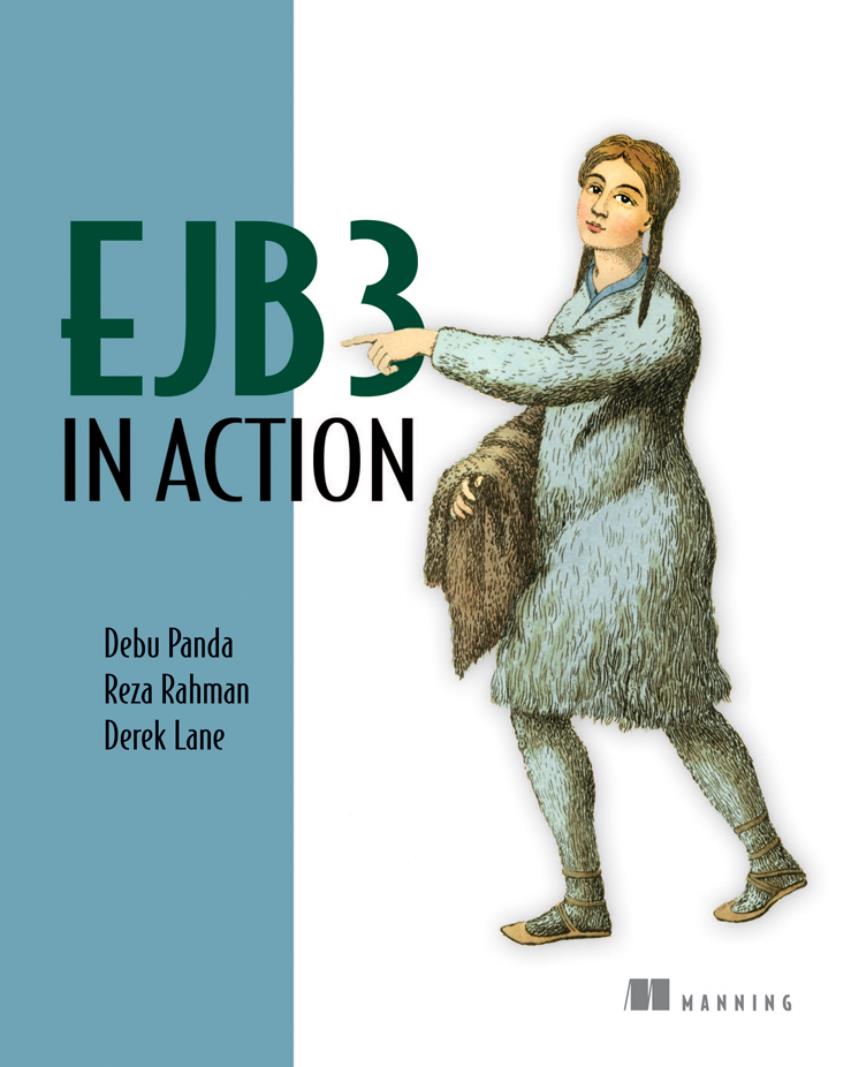
EJB3 IN ACTION Debu Panda Reza Rahman Derek Lane MANNING
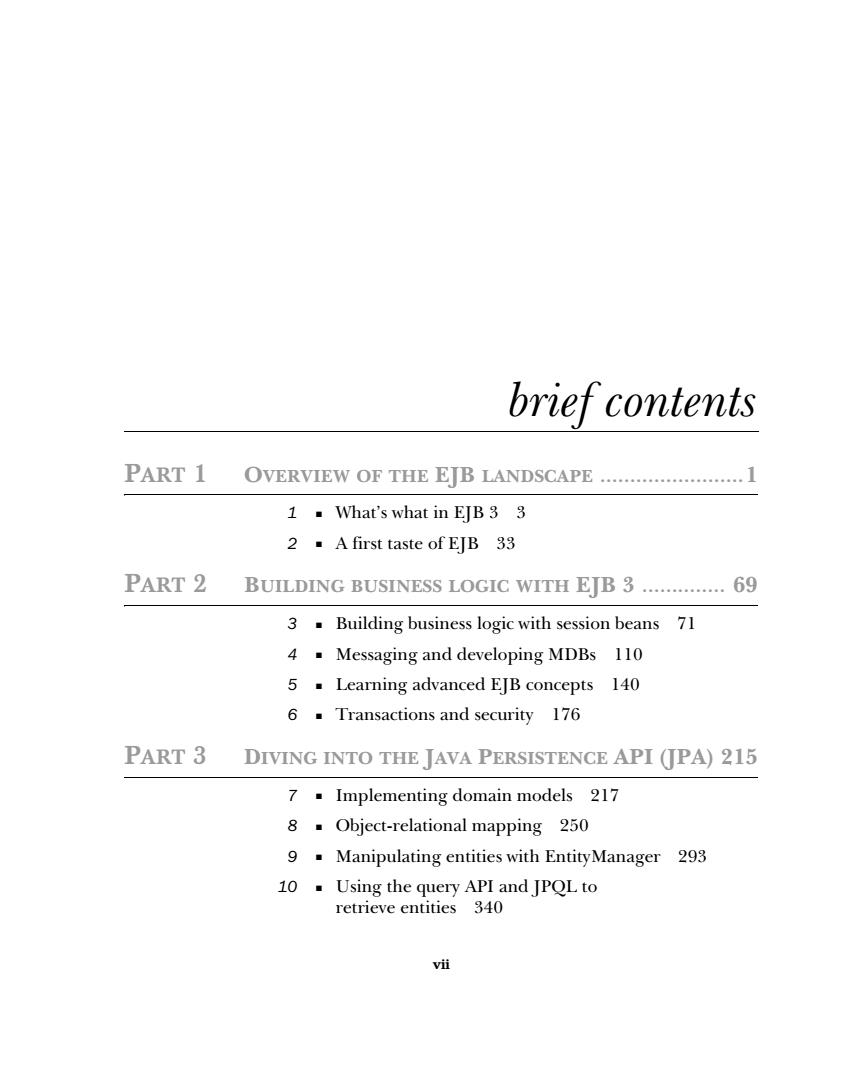
brief contents PART 1 OVERVIEW OF THE EJB LANDSCAPE...................... 1·What's what in EJB33 2.A first taste of EJB 33 PART 2 BUILDING BUSINESS LOGIC WITH EJB 3 .........69 3.Building business logic with session beans 71 4.Messaging and developing MDBs 110 5 Learning advanced EJB concepts 140 6.Transactions and security 176 PART 3 DIVING INTO THE JAVA PERSISTENCE API (JPA)215 7.Implementing domain models 217 8.Object-relational mapping 250 9.Manipulating entities with Entity Manager 293 10.Using the query API and JPQL to retrieve entities 340
vii PART 1 OVERVIEW OF THE EJB LANDSCAPE ........................ 1 1 ■ What’s what in EJB 3 3 2 ■ A first taste of EJB 33 PART 2 BUILDING BUSINESS LOGIC WITH EJB 3 .............. 69 3 ■ Building business logic with session beans 71 4 ■ Messaging and developing MDBs 110 5 ■ Learning advanced EJB concepts 140 6 ■ Transactions and security 176 PART 3 DIVING INTO THE JAVA PERSISTENCE API (JPA) 215 7 ■ Implementing domain models 217 8 ■ Object-relational mapping 250 9 ■ Manipulating entities with EntityManager 293 10 ■ Using the query API and JPQL to retrieve entities 340 brief contents
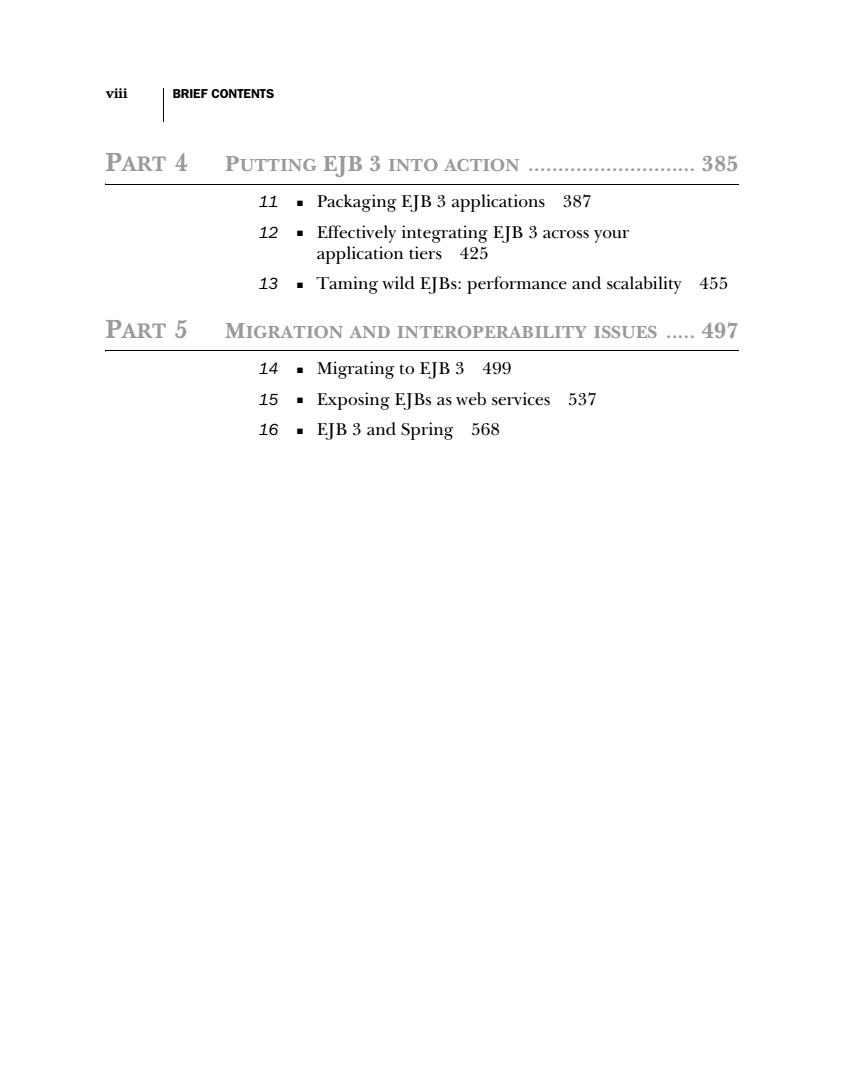
BRIEF CONTENTS PART 4 PUTTING EJB 3 INTO ACTION.385 11.Packaging EJB 3 applications 387 12 Effectively integrating EJB3across your application tiers 425 13.Taming wild EJBs:performance and scalability 455 PART 5 MIGRATION AND INTEROPERABILITY ISSUES ....497 14.Migrating to EJB 3 499 15 Exposing EJBs as web services 537 16·EJB3 and Spring568
viii BRIEF CONTENTS PART 4 PUTTING EJB 3 INTO ACTION ............................ 385 11 ■ Packaging EJB 3 applications 387 12 ■ Effectively integrating EJB 3 across your application tiers 425 13 ■ Taming wild EJBs: performance and scalability 455 PART 5 MIGRATION AND INTEROPERABILITY ISSUES ..... 497 14 ■ Migrating to EJB 3 499 15 ■ Exposing EJBs as web services 537 16 ■ EJB 3 and Spring 568
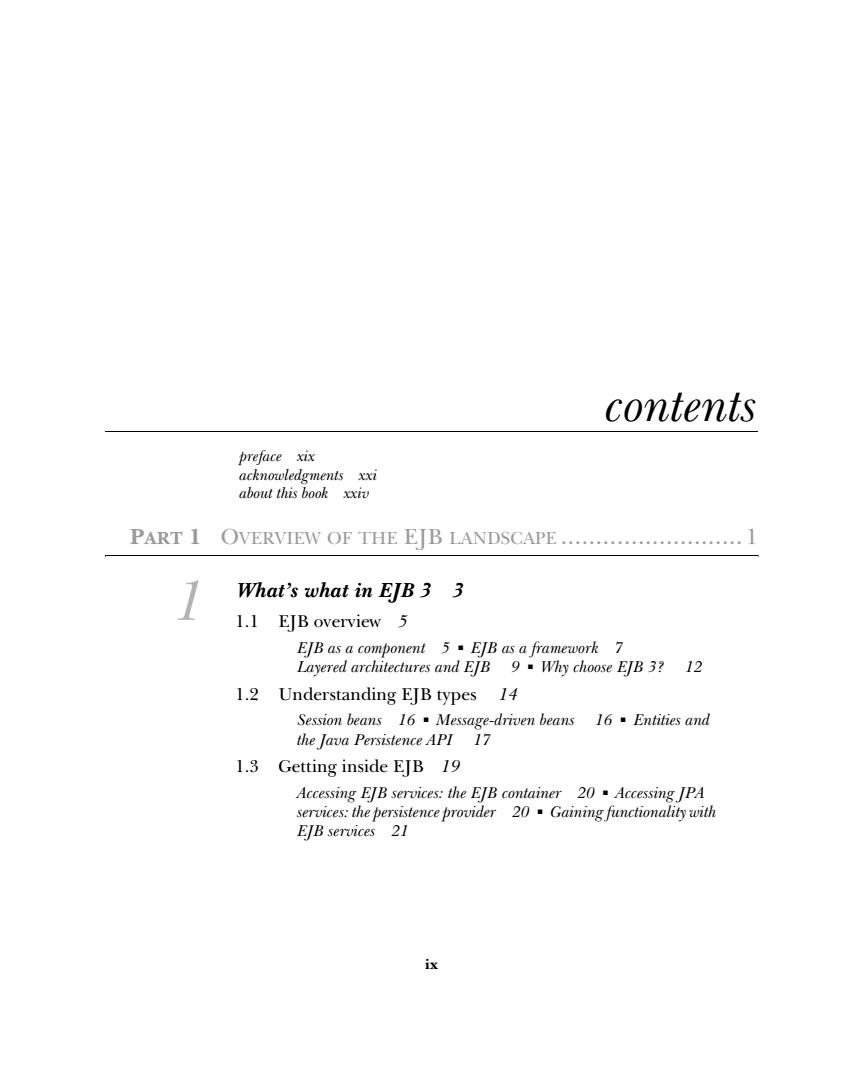
contents preface xix acknowledgments xxi about this book xxiv PART 1 OVERVIEW OF THE EIB LANDSCAPE........................... What's what in EJB 3 3 1.1 EJB overview 5 EJB as a component 5"E[B as a framework 7 Layered architectures and EJB 9.Why choose EJB 3?12 1.2 Understanding EJB types 14 Session beans 16.Message-driven beans 16.Entities and the Java Persistence API 17 1.3 Getting inside EJB 19 Accessing E[B services:the E[B container 20.Accessing PA services:the persistence provider 20.Gaining functionality with EJB services 21 ix
ix preface xix acknowledgments xxi about this book xxiv PART 1 OVERVIEW OF THE EJB LANDSCAPE .......................... 1 1 What’s what in EJB 3 3 1.1 EJB overview 5 EJB as a component 5 ■ EJB as a framework 7 Layered architectures and EJB 9 ■ Why choose EJB 3? 12 1.2 Understanding EJB types 14 Session beans 16 ■ Message-driven beans 16 ■ Entities and the Java Persistence API 17 1.3 Getting inside EJB 19 Accessing EJB services: the EJB container 20 ■ Accessing JPA services: the persistence provider 20 ■ Gaining functionality with EJB services 21 contents
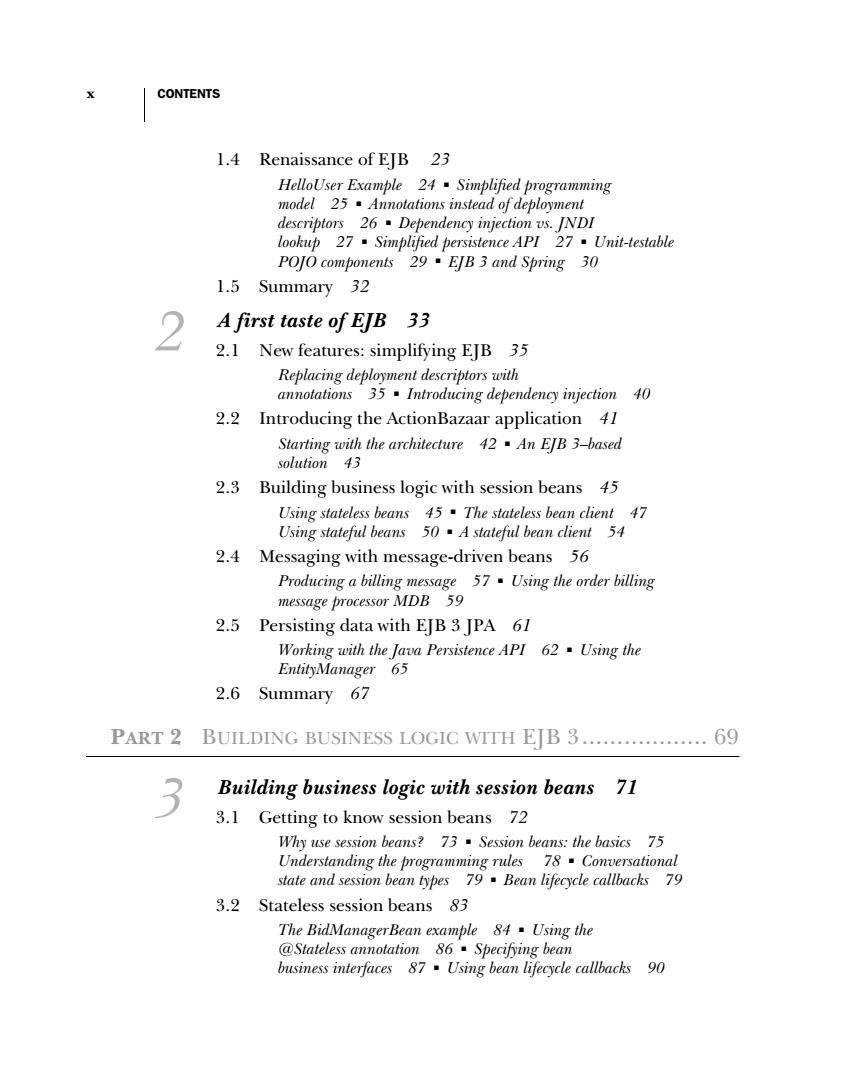
CONTENTS 1.4 Renaissance of EJB 23 d of depl POJO components 29.EJB 5 and Spring 50 1.5 Summary 32 A first taste of EJB 33 2.1 New features:simplifying EJB 35 ing dependency injection 40 2.2 Introducing the ActionBazaar application 41 Starting with the architecture 42.An E[B 3-based solution 43 2.3 Building business logic with session beans 45 Using stateless beans 45The stateless bean client 47 Using stateful beans 50"A stateful bean client 54 2.4 Messaging with message-driven beans 56 Producing a billing message 57.Using the order billing message processor MDB 59 2.5 Persisting data with EJB 3 JPA 61 2.6 Summary 67 PART 2 BUILDING BUSINESS LOGIC WTTH EJB 3..................69 3 Building business logic with session beans 71 3.1 Getting to know session beans 72 Why use session beans?73.Session beans:the basics 75 Understanding the programming rules 78.Conversational state and session bean types 79.Bean lifecycle callbacks 79 3.2 Stateless session beans 83 The BidManagerBean example 84.Using
x CONTENTS 1.4 Renaissance of EJB 23 HelloUser Example 24 ■ Simplified programming model 25 ■ Annotations instead of deployment descriptors 26 ■ Dependency injection vs. JNDI lookup 27 ■ Simplified persistence API 27 ■ Unit-testable POJO components 29 ■ EJB 3 and Spring 30 1.5 Summary 32 2 A first taste of EJB 33 2.1 New features: simplifying EJB 35 Replacing deployment descriptors with annotations 35 ■ Introducing dependency injection 40 2.2 Introducing the ActionBazaar application 41 Starting with the architecture 42 ■ An EJB 3–based solution 43 2.3 Building business logic with session beans 45 Using stateless beans 45 ■ The stateless bean client 47 Using stateful beans 50 ■ A stateful bean client 54 2.4 Messaging with message-driven beans 56 Producing a billing message 57 ■ Using the order billing message processor MDB 59 2.5 Persisting data with EJB 3 JPA 61 Working with the Java Persistence API 62 ■ Using the EntityManager 65 2.6 Summary 67 PART 2 BUILDING BUSINESS LOGIC WITH EJB 3.................. 69 3 Building business logic with session beans 71 3.1 Getting to know session beans 72 Why use session beans? 73 ■ Session beans: the basics 75 Understanding the programming rules 78 ■ Conversational state and session bean types 79 ■ Bean lifecycle callbacks 79 3.2 Stateless session beans 83 The BidManagerBean example 84 ■ Using the @Stateless annotation 86 ■ Specifying bean business interfaces 87 ■ Using bean lifecycle callbacks 90
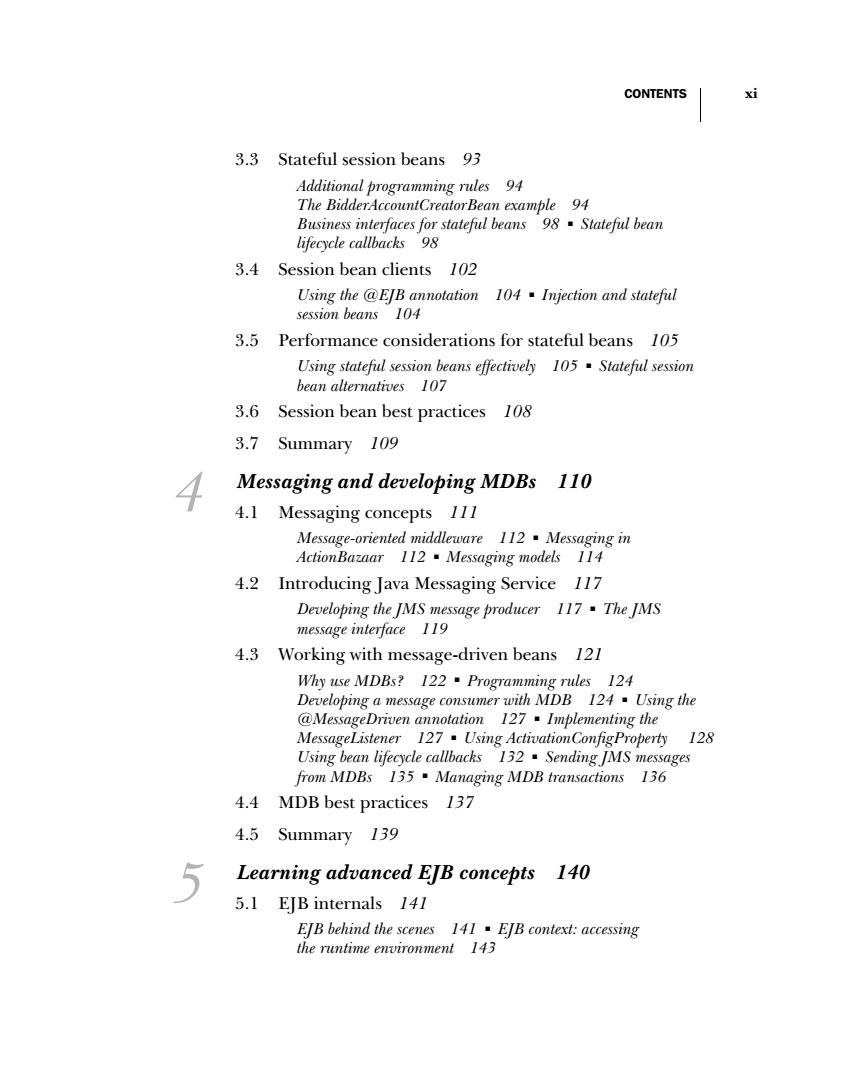
CONTENTS 3.3 Stateful session beans 93 Additional programming rules 94 The BidderAccountCreator Bean example 94 Business interfaces for stateful beans 98Stateful bean lifecycle callbacks 98 3.4 Session bean clients 102 Using the @E[B annotation 104.Injection and stateful session beans 104 3.5 Performance considerations for stateful beans 105 Using stateful session beans effectively 105.Stateful session bean alternatives 107 3.6 Session bean best practices 108 3.7 Summary 109 4 Messaging and developing MDBs 110 4.1 Messaging concepts 111 Message-oriented middleware 112.Messaging in ActionBazaar 112.Messaging models 114 4.2 Introducing Java Messaging Service 117 Developing the JMS message producer 117.The JMS message interface 119 4.3 Working with message-driven beans 121 @MessageDriven annotation 127.Implementing the MessageListener 127.Using ActivationConfigProperty 128 Using bean lifecycle callbacks 132.Sending IMS messages from MDBs 135.Managing MDB transactions 136 4.4 MDB best practices 137 4.5 Summary 139 5 Learning advanced EJB concepts 140 5.1 EIB internals 141 EJB behind the scenes 141.E[B context:accessing the runtime environment 143
CONTENTS xi 3.3 Stateful session beans 93 Additional programming rules 94 The BidderAccountCreatorBean example 94 Business interfaces for stateful beans 98 ■ Stateful bean lifecycle callbacks 98 3.4 Session bean clients 102 Using the @EJB annotation 104 ■ Injection and stateful session beans 104 3.5 Performance considerations for stateful beans 105 Using stateful session beans effectively 105 ■ Stateful session bean alternatives 107 3.6 Session bean best practices 108 3.7 Summary 109 4 Messaging and developing MDBs 110 4.1 Messaging concepts 111 Message-oriented middleware 112 ■ Messaging in ActionBazaar 112 ■ Messaging models 114 4.2 Introducing Java Messaging Service 117 Developing the JMS message producer 117 ■ The JMS message interface 119 4.3 Working with message-driven beans 121 Why use MDBs? 122 ■ Programming rules 124 Developing a message consumer with MDB 124 ■ Using the @MessageDriven annotation 127 ■ Implementing the MessageListener 127 ■ Using ActivationConfigProperty 128 Using bean lifecycle callbacks 132 ■ Sending JMS messages from MDBs 135 ■ Managing MDB transactions 136 4.4 MDB best practices 137 4.5 Summary 139 5 Learning advanced EJB concepts 140 5.1 EJB internals 141 EJB behind the scenes 141 ■ EJB context: accessing the runtime environment 143

xii CONTENTS 5.2 Accessing resources using DI and JNDI 146 155 5.3 AOP in the EJB world:interceptors 157 What is AOP?157.What are interceptors?158 Specifying interceptors 160.Implementing business intercep callback methods in the 5.4 Scheduling:the EJB 3 timer service 167 5.5 Summary 175 Transactions and security 176 6.1 Understanding transactions 177 A transactional solution in ActionBazaar 178 ACID properties 178.Transaction management internals 181.Two-phase commit 183 Transaction management in E[B 184 6.2 Container-managed transactions 185 Snag-It ordering using CMT 185 The @TransactionManagement annotation 186 The @TransactionAttribute annotation 187 Marking a CMT for rollback 191Transaction and exception ha ndling 193 6.3 Bean-managed transactions 196 Snag-It ordering using BMT 196.Getting a UserTransaction 198.Using UserTransaction 199 The pros and cons of BMT 201 6.4 Exploring EJB security 202 Authentication vs.authorization 202.Users,groups, and roles 203.A security problem in ActionBazaar 203 EIB 3 and Java EE se 205 Declo an208·Using B programmatic securi20 6.5 Summary 213
xii CONTENTS 5.2 Accessing resources using DI and JNDI 146 Resource injection using @Resource 146 ■ The @Resource annotation in action 152 ■ Looking up resources and EJBs 155 5.3 AOP in the EJB world: interceptors 157 What is AOP? 157 ■ What are interceptors? 158 Specifying interceptors 160 ■ Implementing business interceptors 162 ■ Lifecycle callback methods in the interceptor class 165 5.4 Scheduling: the EJB 3 timer service 167 What are timers? 168 ■ Using the timer service 169 When to use EJB timers 174 5.5 Summary 175 6 Transactions and security 176 6.1 Understanding transactions 177 A transactional solution in ActionBazaar 178 ACID properties 178 ■ Transaction management internals 181 ■ Two-phase commit 183 Transaction management in EJB 184 6.2 Container-managed transactions 185 Snag-It ordering using CMT 185 The @TransactionManagement annotation 186 The @TransactionAttribute annotation 187 ■ Marking a CMT for rollback 191 ■ Transaction and exception handling 193 6.3 Bean-managed transactions 196 Snag-It ordering using BMT 196 ■ Getting a UserTransaction 198 ■ Using UserTransaction 199 The pros and cons of BMT 201 6.4 Exploring EJB security 202 Authentication vs. authorization 202 ■ Users, groups, and roles 203 ■ A security problem in ActionBazaar 203 EJB 3 and Java EE security 205 ■ Declarative security 208 ■ Using EJB programmatic security 210 6.5 Summary 213

CONTENTS xi甜 PART 3 DIVING INTO THE JAVA PERSISTENCE API (JPA).....215 Implementing domain models 217 7.1 Domain modeling and the JPA 218 Introducing domain models 219.The ActionBazaar 224·Domain object as Java classes 225 7.2 Implementing domain objects with JPA 227 The @Entity annotation 228.Persisting entity data 229 Ch nti identity 233 238 7.3 Entity relationships 239 @OneToOne 240.@OneToMany and @ManyToOne 244.@ManyToMany 247 7.4 Summary 249 8 Object-relational mapping 250 8.1 The impedance mismatch 251 257 8.2 Mapping entities 258 Specifying the table 261.Mapping the columns 262 Using @Enumerated 264.Mapping CLOBs and BLOBs 265.Mapping temporal types 265 Mapping an entity to multiple tables 266 26> Mapping embe 8.3 Mapping entity relationships 273 ppite one-lo-me velntonskps3 One-to-many on me278·May-lo nany 281 8.4 Mapping inheritance 284 Single-table strategy 285"Joined-tables strategy 287.Table-per-class strategy 288 Mapping polymorphic relationships 291 8.5 Summary 292
CONTENTS xiii PART 3 DIVING INTO THE JAVA PERSISTENCE API (JPA)..... 215 7 Implementing domain models 217 7.1 Domain modeling and the JPA 218 Introducing domain models 219 ■ The ActionBazaar problem domain 219 ■ Domain model actors 222 The EJB 3 Java Persistence API 224 ■ Domain objects as Java classes 225 7.2 Implementing domain objects with JPA 227 The @Entity annotation 228 ■ Persisting entity data 229 Specifying entity identity 233 The @Embeddable annotation 238 7.3 Entity relationships 239 @OneToOne 240 ■ @OneToMany and @ManyToOne 244 ■ @ManyToMany 247 7.4 Summary 249 8 Object-relational mapping 250 8.1 The impedance mismatch 251 Mapping objects to databases 252 Introducing O/R mapping 257 8.2 Mapping entities 258 Specifying the table 261 ■ Mapping the columns 262 Using @Enumerated 264 ■ Mapping CLOBs and BLOBs 265 ■ Mapping temporal types 265 Mapping an entity to multiple tables 266 Generating primary keys 267 Mapping embeddable classes 270 8.3 Mapping entity relationships 273 Mapping one-to-one relationships 273 ■ One-to-many and many-to-one 278 ■ Many-to-many 281 8.4 Mapping inheritance 284 Single-table strategy 285 ■ Joined-tables strategy 287 ■ Table-per-class strategy 288 Mapping polymorphic relationships 291 8.5 Summary 292

xiv CONTENTS Manipulating entities with EntityManager 293 9.1 Introducing the EntityManager 294 in ActionBazaar 303 9.2 Creating Entity Manager instances 304 Container-managed EntityManagers 305 Applicntion-managed EntityManager 308 9.3 Managing persistence operations 313 Persisting entities 314.Retrieving entities by primary key 319 Updating entities 325.Deleting entities 328 Controlling updates with flush 330 Refreshing entities 331 9.4 Entity lifecycle listeners 333 Using an entity listener 334.Default listener classes 336 Listener class execution order and exclusion 337 9.5 Entity operations best practices8 9.6 Summary 338 10 Using the query API and JPOL to retrieve entities 340 10.1 Introducing the query API 341 The big picture 341.Anatomy of a query 343 Defining named queries 344 10.2 Executing the queries 345 Creating a query instance 346.Working with the Que叮interface347·Specifying query hints353 10.3 Introducing JPQL 354 Defining statement types 356.Using the FROM clause 358 Conditional expressions and operators 562.Working with POL functions 367 Using a SELECT clause 370 Using aggregations 372"Ordering the query result 374 Using subqueries 374.Joining entities 376 Bulk updates and deletes 379 10.4 Native SQL queries 380 Using dynamic queries with native SQL 381Using a named native SQL que叮382 10.5 Summary 383
xiv CONTENTS 9 Manipulating entities with EntityManager 293 9.1 Introducing the EntityManager 294 The EntityManager interface 294 ■ The lifecycle of an entity 297 ■ Persistence contexts, scope, and the EntityManager 301 ■ Using the EntityManager in ActionBazaar 303 9.2 Creating EntityManager instances 304 Container-managed EntityManagers 305 Application-managed EntityManager 308 9.3 Managing persistence operations 313 Persisting entities 314 ■ Retrieving entities by primary key 319 Updating entities 325 ■ Deleting entities 328 Controlling updates with flush 330 ■ Refreshing entities 331 9.4 Entity lifecycle listeners 333 Using an entity listener 334 ■ Default listener classes 336 Listener class execution order and exclusion 337 9.5 Entity operations best practices 338 9.6 Summary 338 10 Using the query API and JPQL to retrieve entities 340 10.1 Introducing the query API 341 The big picture 341 ■ Anatomy of a query 343 Defining named queries 344 10.2 Executing the queries 345 Creating a query instance 346 ■ Working with the Query interface 347 ■ Specifying query hints 353 10.3 Introducing JPQL 354 Defining statement types 356 ■ Using the FROM clause 358 Conditional expressions and operators 362 ■ Working with JPQL functions 367 ■ Using a SELECT clause 370 Using aggregations 372 ■ Ordering the query result 374 Using subqueries 374 ■ Joining entities 376 Bulk updates and deletes 379 10.4 Native SQL queries 380 Using dynamic queries with native SQL 381 ■ Using a named native SQL query 382 10.5 Summary 383
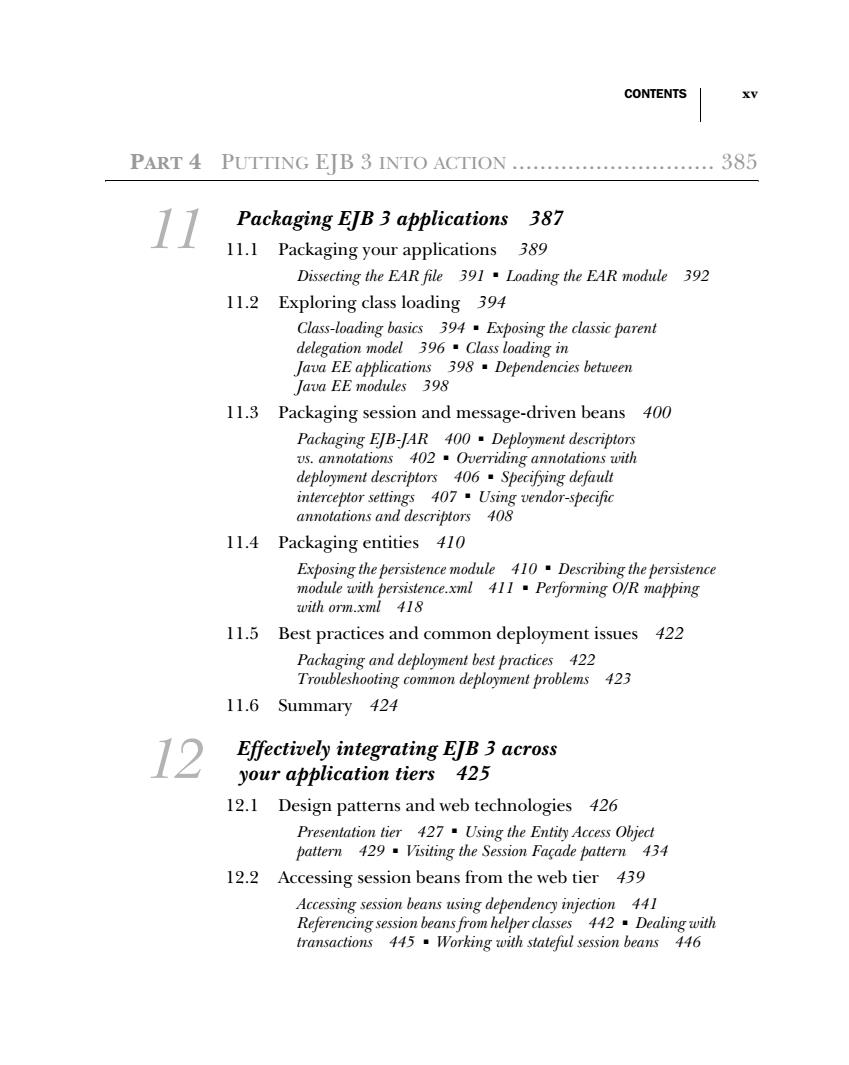
CONTENTS PART 4 PUTTING EJB 3 INTO ACTION..............................385 11 Packaging EJB3 applications 387 11.1 Packaging your applications 389 Dissecting the EAR file 391.Loading the EAR module 392 11.2 Exploring class loading 394 Class-loading basics 394 Exposing the classic parent delegation model 396"Class loading in Java EE applications 398.Dependencies between Java EE modules 398 11.3 Packaging session and message-driven beans 400 Packaging E[B-JAR 400.Deployment descriptors vs.annotations 402.Overriding annotations with deployment descriptors 406.Specifying default inter vendor-specific 11.4 Packaging entities 410 Exbosing the bersistence module 410 Describing the bersistence module with b rsistence.xml 411.Performing O/R mapping with orm.xml 418 11.5 Best practices and common deployment issues 422 m2 oting common deployment problems 423 11.6 Summary 424 12 Effectively integrating EB 3 across your application tiers 425 12.1 Design patterns and web technologies 426 Presentation tier 427.Using the Entity Access Object pattern 429.Visiting the Session Facade pattern 434 12.2 Accessing session beans from the web tier 439 Accessing session beans using dependency injection 441 Referen ng session beans from helper classes 442.Dealing with transactions 445 Working with stateful session beans 446
CONTENTS xv PART 4 PUTTING EJB 3 INTO ACTION ............................. 385 11 Packaging EJB 3 applications 387 11.1 Packaging your applications 389 Dissecting the EAR file 391 ■ Loading the EAR module 392 11.2 Exploring class loading 394 Class-loading basics 394 ■ Exposing the classic parent delegation model 396 ■ Class loading in Java EE applications 398 ■ Dependencies between Java EE modules 398 11.3 Packaging session and message-driven beans 400 Packaging EJB-JAR 400 ■ Deployment descriptors vs. annotations 402 ■ Overriding annotations with deployment descriptors 406 ■ Specifying default interceptor settings 407 ■ Using vendor-specific annotations and descriptors 408 11.4 Packaging entities 410 Exposing the persistence module 410 ■ Describing the persistence module with persistence.xml 411 ■ Performing O/R mapping with orm.xml 418 11.5 Best practices and common deployment issues 422 Packaging and deployment best practices 422 Troubleshooting common deployment problems 423 11.6 Summary 424 12 Effectively integrating EJB 3 across your application tiers 425 12.1 Design patterns and web technologies 426 Presentation tier 427 ■ Using the Entity Access Object pattern 429 ■ Visiting the Session Façade pattern 434 12.2 Accessing session beans from the web tier 439 Accessing session beans using dependency injection 441 Referencing session beans from helper classes 442 ■ Dealing with transactions 445 ■ Working with stateful session beans 446